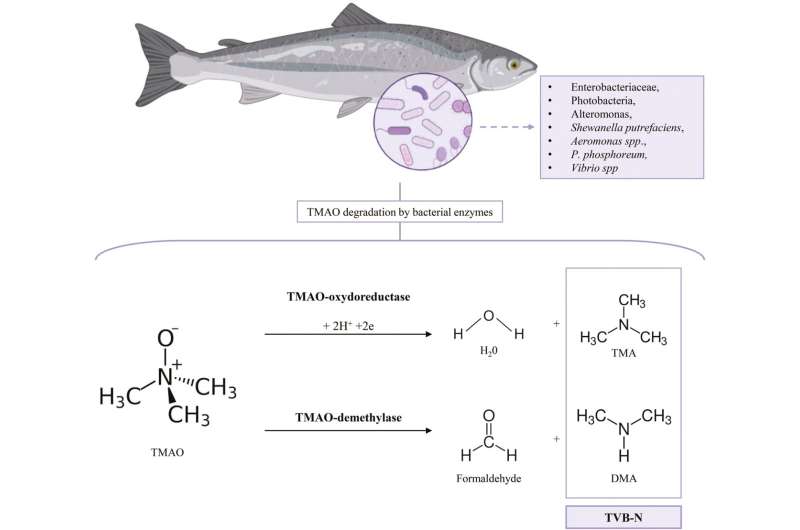This article has been reviewed according to Science X's editorial process and policies. Editors have highlighted the following attributes while ensuring the content's credibility:
fact-checked
proofread
Food safety, quality review summarizes sustainable seafood preservation to minimize waste, losses

Seafood is in high demand across several regions of the world. Moreover, this demand for seafood is expected to surge by a whopping 56% by 2050. Given the high moisture content and susceptibility of seafood to microbial and biochemical decay, it often requires heavy processing and preservation to retain freshness, unique composition, and flavors.
Despite this, however, the seafood processing industry generates enormous amounts of waste products that sometimes even exceed the amount of actual edible produce. Improper waste disposal and spoilage of seafood can further have serious environmental, financial, and health consequences.
Sustainable processing and preservation methods are therefore needed to ensure the maintenance of prolonged quality of seafood, while minimizing the environmental and economic impact from the generated wastes.
Often, traditional methods are employed for the purpose of seafood preservation. These include drying, salting, canning, fermentation, pickling, sugaring, sun-drying, traditional fermentation, potting, refrigeration, and freezing storage. While these methods help improve the shelf life of seafood, they may end up altering the taste, texture, and flavors of seafoods, hampering their edibility.
In addition, using these methods also requires stringent measures to maintain hygiene and efficiency, which can incur additional costs. Recently, however, several innovative physical and chemical methods have come to the fore, possessing the ability to reshape seafood processing into an economically and environmentally sustainable process.
Now, in a review article published in Food Quality and Safety, researchers shed light on some of these recent pioneering physical and chemical advanced techniques that can effectively mitigate seafood wastage and improve productivity.
The review was co-authored by Dr. Luisa Diomede, Dr. Andrea Conz, Dr. Enrico Davoli, and Dr. Carlotta Franchi from Istituto di Ricerche Farmacologiche Mario Negri IRCCS, Milano, Italy, as part of the Project "ON Foods-Retwork of Research and Innovation on Sustainability, Food Safety and Nutrition-Working ON Foods."
Elaborating further on the rationale behind undertaking this study, Dr. Diomede, the corresponding author of the review, says, "The seafood preservation industry, driven by a mission to extend seafood's shelf life, maintain its quality, reduce waste, and minimize environmental consequences, is looking towards innovative methods for this purpose.
"In this review, we sought to evaluate whether the proposed innovations address the intricacies of seafood preservation to meet the surge in demand for seafood, consciously and sustainably."
The researchers conducted a detailed literature survey and identified 49 studies across 23 countries, that focus on the physical and chemical fish preservation techniques. The chemical methods evaluated by them include the use of organic acids and preservatives derived from biological sources, such as microorganisms, plants, or animals.
Weak organic acids, such as acetic acid, citric acid, lactic acid, and ascorbic acid along with their sodium salts help delay lipid and nitrogen metabolism and inhibit microbial growth in seafood products. This contributes to the improvement of shelf life.
Additionally, utilizing a combination of acids can help counteract changes in sensory attributes, smell, and taste associated with specific acids. Considering the species-specific characteristics, unique composition, and the concentration and type of acid can optimize seafood preservation.
Preservatives derived from microbial, plant, or animal-derived metabolites are gaining popularity, given their safety and potential to retain sensory and nutritional attributes of processed seafoods. Among various metabolites, bacteriocins and chitosans, which are Generally Recognized As Safe, have demonstrated potent bio-preservative effects due to their ability to enhance the shelf life and stability of seafoods.
Next, the researchers focus on physical methods that rely on non-thermal approaches by circumventing the need for temperature maintenance, which is often energy- and cost-intensive.
Unlike conventional approaches that require the maintenance of a cold chain or heating, cold plasma (CP), high hydrostatic pressure (HHP), and UV-C irradiation, can operate effectively at ambient temperatures.
CP, an ionized gas distinct from the solid, liquid, and gaseous states, and dielectric barrier discharge-high-voltage cold atmospheric plasma (DBDHVCAP) has demonstrated the ability to inhibit bacterial growth and impede metabolic processes that lead to spoilage, without compromising the quality of seafood.
HHP is another heat-free approach that destroys spoilage-causing microbes and enzymes. Optimizing temperature and pressure conditions can further enhance the effects of this approach. UV-C irradiation serves as another simple and effective decontamination technique, independent of temperature or pH conditions. However, physical methods can accelerate lipid oxidation, necessitating the optimization of treatment conditions.
In a nutshell, this review highlights findings from diverse studies spanning various preservation techniques and fish species. It also focuses on the advantages and challenges associated with each approach. Even as new and advanced approaches are in the wake of development, the need of the hour is to strike an equilibrium between improving shelf life, ensuring consumer safety and satisfaction, economic feasibility and sustainability, while retaining the nutritional value and flavor of the product.
Dr. Diomede says, "Even as the industry grows and progresses in the future, addressing challenges and optimizing fish preservation methods for a sustainable, high-quality seafood supply will remain crucial."
More information: Andrea Conz et al, Seafood loss prevention and waste reduction, Food Quality and Safety (2024). DOI: 10.1093/fqsafe/fyae017
Provided by TranSpread


















